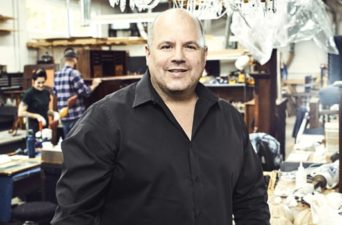Five Questions: David Manzi of Trefler’s
February 7, 2019
David Manzi of Trefler’s offers advice on maintaining and preserving your valuable art and furniture.
Text by Robert Kiener Photography by Michael David Wilson
 1. What is the difference between restoration and conservation?
1. What is the difference between restoration and conservation?
Restoration is a complete overhaul of a piece. For example, if a table was damaged in a fire and needed to be stripped and refinished, that would be a restoration. If the table had sustained just some wear and tear and needed a little attention, such as French polishing, that would call for conservation. We always try to “preserve and conserve,” especially when it comes to antiques, because in most cases, restoration is more severe than conservation. Conservations also secure or stabilize a piece, making sure it will not deteriorate more than it already has.
2. You must work on an amazing range of items that need restoration or conservation. What are some examples?
A lot of our work is on items that have been damaged by fire or water, but we also see many items that have great sentimental value and need to be repaired or conserved, such as a family Bible or even something a customer’s grandchild had made. We have worked on everything from pre-Colombian antiques to more modern pieces. We’ve restored a chair once owned by Napoleon, artwork by Caravaggio, Rembrandt, and Picasso, silverware made by Paul Revere—the list goes on and on. A Boston family brought in a copper bed warmer that came over on the Mayflower. And recently, we restored a diary my grandfather wrote when he landed at Guadalcanal in World War II. I look at it every day; it is remarkable. Bringing these kinds of memories back on a daily basis for people is what makes our work so special for us.
3. Do you feel that some of these pieces you work on have a soul?
Exactly! I am a history major and I love learning about the history of the pieces that come in. For example, we are working on a grandfather clock from the 1700s that’s in a home in Lexington, Massachusetts. When you look at it, you realize you are seeing the same dial that perhaps one of the Minutemen looked at when he was heading out on the morning of April 19, 1775. That piece has a soul; it has a history that is older than the country itself. One of our conservators who was working on a Ming Dynasty vase was almost moved to tears when she put her hand inside the vase and felt the grooves made by the hands of the original potter. It is a privilege to work on pieces like this.
4. Is there something homeowners often overlook when it comes to insuring their artwork and antiques?
We recommend that owners have detailed, professional photographs taken of their valuable pieces. This gives them an opportunity to document, for example, that eighteenth-century grandfather clock, including its historical components, its condition, what restoration it may need, or if it has already had any restoration. These photographs can be used for insurance purposes, if, God forbid, there is ever damage to the piece. Documentation also helps with valuations on an insurance policy. Speaking of insurance, homeowners should also make sure that they have recent, up-to-date appraisals on their valuable items because the market changes often.
5. What about preventive maintenance tips?
In the dry season, if you don’t have a humidifier, put a bowl of water underneath a dresser or cabinet. This will help the overall structure of the piece, keeping it from drying out or warping and helping to stop existing cracks from expanding. Shades or filtered UV film on your windows can also prevent sun damage. If you have a painting over a mantel, you might want to have it cleaned every few years so soot doesn’t build up. Soot is very acidic, and that acidic nature can cause paint and fibers in the canvas to break down over time. Also, when people start putting on their heat, they should make sure their vents are clean. There is nothing worse than when a boiler kicks on and an oil spray comes out of the vent and affects furniture, muslin, china, and anything else that’s porous.
Trefler’s, Newton, Mass., trefler.com
Share
![NEH-Logo_Black[1] NEH-Logo_Black[1]](https://www.nehomemag.com/wp-content/uploads/2022/08/NEH-Logo_Black1-300x162.jpg)








You must be logged in to post a comment.